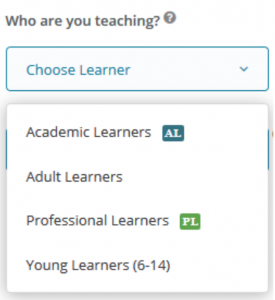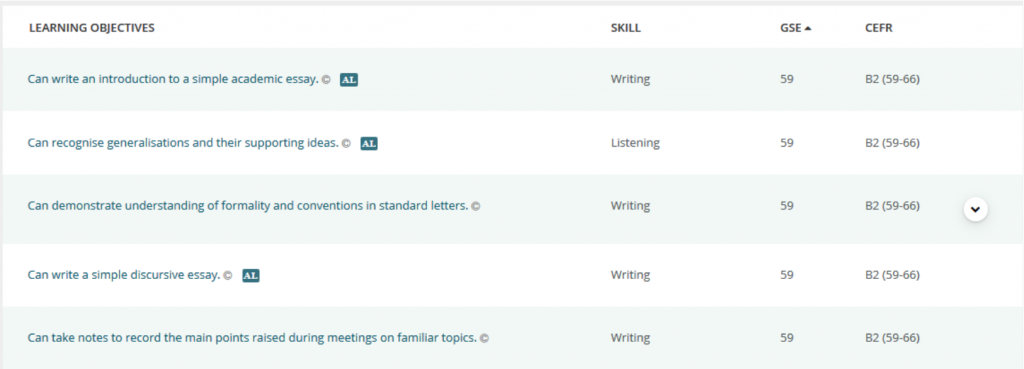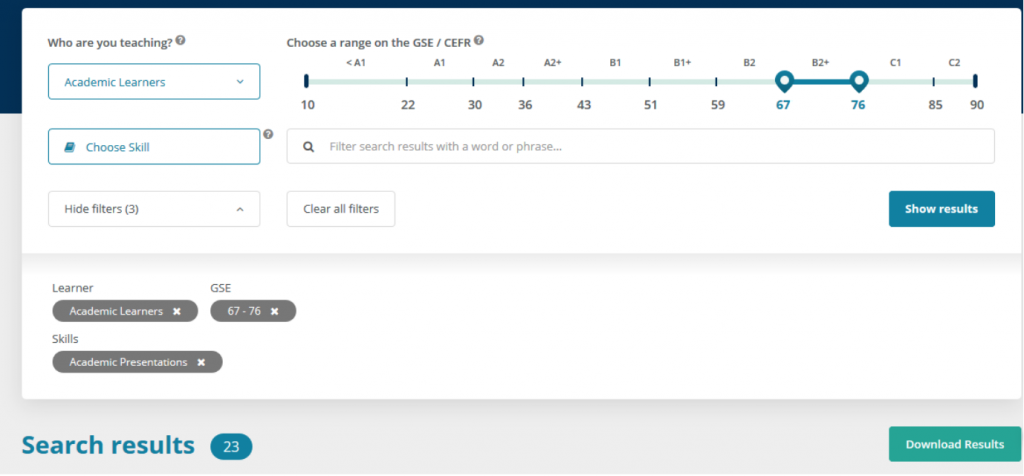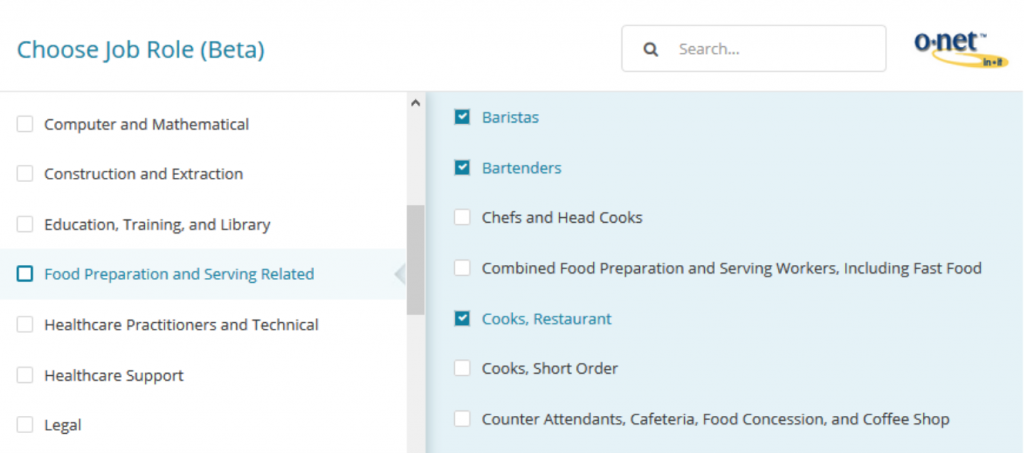The Global Scale of English (GSE) Teacher Toolkit has everything you need to plan engaging and appropriate lessons for your learners.
Consisting of over 2,000 Learning Objectives, as well as hundreds of grammar points and thousands of word meanings and collocations, the database is easy for teachers to use and navigate.
It can help you choose age and level-appropriate content for your students. It is also an ideal platform for teachers who are working in schools with limited resources, as well as for those who want to complement their coursebook with additional activities.
Here are three reasons to use the GSE Teacher Toolkit to plan your lessons:
1. Learner-appropriate Objectives
One of the best things about the GSE Teacher Toolkit is that you can identify your group of learners on the platform and then choose appropriate Learning Objectives for them.
This makes it easy for you to decide on clear and tangible aims for your lessons. You can then plan your classes according to what your students should be able to do at their level.
Learning Objectives are linked to each range of abilities on the GSE scale – and those which are specific to Academic Learners (AL) or Professional Learners (PL) are clearly highlighted.
If you select Professional Learners, you can choose Learning Objectives for particular industries. This is useful for teachers working with groups of learners with specific professional requirements and interests.
Moreover, you can decide whether to focus on Language or Business Skills. The toolkit then allows you to choose which professional field your students are working in. There are 20 options on the Job Role list, including Architecture and Engineering, Personal Care and Service and Office and Administrative Support.
For more ideas on how you can use the GSE Teacher Toolkit to help students who are entering the job market, read this article on preparing learners for work.
2. Clear examples of grammatical structures
When you’re deciding on which grammar points to work on in class, the GSE Teacher Toolkit allows you to search by category and provides example sentences for each point. It also links each grammar point to specific Learning Objectives so you can easily identify the communicative or functional aims of your lesson.
3. Age-appropriate Vocabulary
When preparing your own materials, you can be sure that the vocabulary you’re including in your lessons is relevant to your students.
That’s why it’s important to select the age of your students when choosing Vocabulary. Words are sometimes listed in a different range of the GSE, depending on the age of the students in question.
For example, dinosaur is an A1 (GSE 29) word for Young Learners, yet for Adult Learners it’s listed as a B2 (GSE 61) word – and this reflects the frequency at which different age learners use these words in everyday life.
Check out this article for further ideas on how to use the GSE Teacher Toolkit to plan a lesson for your Young Learners.
How the GSE Teacher Toolkit is helping teachers around the world
The GSE and GSE Teacher Toolkit is being used by education centres around the globe to support students and teachers to improve the learning experience. In Japan, for example, it is being used to raise the standard of English amongst students in language schools and universities.
Here are three scenarios where the GSE Teacher Toolkit can be used to support teachers in different contexts:
1. A focus on Academic Skills
 In this scenario, a university lecturer wants her students to improve their professional presentation skills in English.
In this scenario, a university lecturer wants her students to improve their professional presentation skills in English.
“I’m a lecturer in Medicine at an English-medium university. We have a pre-selected coursebook, but I’m finding there aren’t enough opportunities for improving students’ communicative skills.
The students are all B2+ level, but need to be able to articulate their subject matter expertise by delivering a short lecture to their peers. Each student will be assessed by their peers on the quality of the delivery and understanding of the topic. This is something the class wants to focus on to be successful in their final English certification and finding employment. How can I identify the skills they need?”
How the GSE Teacher Toolkit can help
It’s a great idea to work on presentation skills. It will benefit them not only in their academic life, but also in finding employment in the future.
The GSE Teacher Toolkit can help you find tangible Learning Objectives so that you can work on these presentation skills safe in the knowledge that you are working towards a clear goal.
On the Learning Objectives tab, select Academic Learners, and choose the range B2+ (GSE 67-76).
In the Skills dropdown menu, select Academic Skills, then in the Academic Discourse dropdown menu, click on Academic Presentations.
This will give you 23 Learning Objectives to integrate into your syllabus to help the students develop their communication skills. Find the search results here.
The Learning Objectives focus both on presenting material and listening to presentations, meaning that you can work on productive and receptive skills at the same time.
2. Matching course content to the emerging job market
In this scenario, a director of studies at a private language school wants to increase her students’ exposure to English outside the classroom.
“I’m the Director of Studies at a private language school. My students are young professionals who are ambitious, but have limited exposure to English outside the classroom – except for social media or entertainment. Competition for well-paid jobs is limited in our area, except for the emerging tourism, service and construction industries. I know these young adults will have an advantage over their peers, if they improve their English, alongside their professional skills. I can see that there’s an opportunity to overhaul the current course and appeal to this emerging market at a time of investment in the country. If I adapt the course content to match job roles and relevant industry skills, it would be a success, but I’m not sure where to start.”
How the GSE Teacher Toolkit can help
Knowing about the employment opportunities in your local area means that you can tailor your content to strengthen your students’ communicative and linguistic skills in those areas. With the option of searching for content by profession on the GSE Teacher Toolkit, you can identify the specific Learning Objectives for your students in each area.
On the Learning Objectives tab, select Professional Learners from the dropdown menu. By clicking on the Job Role menu, you can select the industry and specific positions within it.
When you have identified the professions you want to focus on, you can choose which Skills to work on and select the level of your students on the scale.
For example, imagine you want to focus on the food industry, primarily on improving the speaking skills of people who will have direct contact with customers, such as waiting staff, baristas and bartenders.
In your class, you have a range of levels, from A1 to B1 and want to cater to the needs of the different students. By doing a search for those variables, you get 38 Learning Objectives which you can then integrate into a syllabus.
Furthermore, you can select level-appropriate vocabulary to teach the students by searching for Food and Drink and selecting the same range on the scale.
3. Using Pearson Assessment to identify needs
In this scenario a community college teacher wants to help her students pass their English exams so they have more employment opportunities.
“I teach at a community college, where the students are adult learners hoping to gain a basic mastery of English to find employment opportunities in a new country. Each student is motivated to succeed, as their ability to find work will be limited if they don’t pass an assessment in English. All students are all non-native speakers but there’s a big mix of levels in each of my classes. I’m concerned that some of the more accomplished learners will find the classes boring, as they’ll need to cover previous learning. How can I differentiate instruction to keep everyone engaged, motivated and progressing?”
How the GSE Teacher Toolkit can help
It’s tricky to work with different levels within the same class, but the first step is to identify the students’ strengths and weaknesses in different skills.
Pearson English Placement is a 35-minute online assessment which tests your students’ listening, reading and writing skills along with grammar and vocabulary. The results are aligned to the GSE making it much easier for you to then identify relevant Learning Objectives for each student.
When you know the levels within your class and the areas which different individuals need to work on, you can look at appropriate Learning Objectives.
Once you understand what’s expected of your students, you can prepare materials which are relevant to their level. This will help you to support struggling members of the class whilst at the same time allowing more advanced students to progress.
Also, if your students are hoping to find work in an English-speaking country, you may like to look at the Learning Objectives for Meeting Practical Needs in the Skills section. This shows a number of everyday communicative tasks your students will find useful for life in a new country. Most Learnings also list relevant grammar points to focus on, further helping your students in their English language learning.
—
Find out more about the Global Scale of English and Pearson Assessment.
The post What’s in my GSE Teacher Toolkit? appeared first on Resources for English Language Learners and Teachers | Pearson English.
from Resources for English Language Learners and Teachers | Pearson English http://bit.ly/2vHMsiS
via Learn Online English Speaking








Comments
Post a Comment